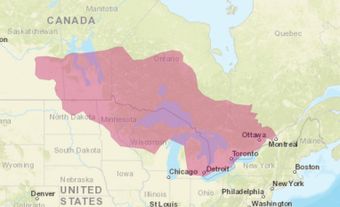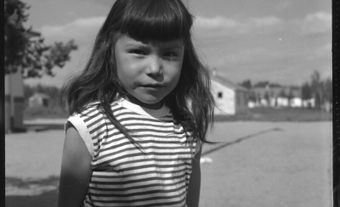Mississauga, Ontario, incorporated as a city in 1974, population 717,961 (2021 census), 721,599 (2016 census). The city was created by the amalgamation of the Town of Mississauga and the Towns of Port Credit and Streetsville. Located west of Toronto, Mississauga is part of the Regional Municipality of Peel. It is located within the Credit and Humber river watersheds. Throughout history, the Mississauga area has been home to different Indigenous groups, namely the Huron-Wendat, Haudenosaunee and Anishinaabeg, including the Mississauga. The land is covered by treaties 14, 19, 22 and 23.
Indigenous Peoples
Indigenous peoples have lived in the Mississauga area for thousands of years, particularly near the Credit and Humber rivers. When Europeans arrived in the 1600s, French traders allied with the Huron-Wendat and became enemies with the Haudenosaunee. The Iroquois Wars, fought in part over the control of the fur trade during the 17th century, depopulated the Huron-Wendat. Diseases introduced by the Europeans also decimated the Huron-Wendat population.
In the early 1700s, the Anishinaabeg, including the Mississauga, began migrating to southwestern Ontario. In particular, they settled along the shores of Lake Ontario. Today, Indigenous peoples make up 0.6 per cent of Mississauga’s population.
Treaties
Two treaty land acquisitions created Toronto Township (now Mississauga). In 1806, Mississauga chiefs signed Treaty 14, known as the Head of the Lake Purchase. The purchase, originally agreed on in 1805 as an amendment to Treaty 13, ceded 85,000 acres (344 km2) of land to the Crown in exchange for fishing rights and £1,000 worth of goods. The second treaty was signed in 1818 and was known as the Ajetance Purchase or Treaty 19. It surrendered 2,622 km2 of Mississauga land to the Crown. In exchange, the Mississaugas of the Credit were to receive £522 and 10 shillings in goods every year.

After further encroachments from settlers, the Mississauga surrendered more land along the Credit River in treaties 22 and 23, signed in 1820. They received £51 between the parcels of land. Treaty 22 also promised them 200 acres (0.8 km2) on the bank of the Credit River. (See also Upper Canada Land Surrenders.)
Credit River Mission Village
Superintendent of Indian Affairs James Givens and a Mississauga man named Peter Jones (Kahkewaquonaby) established a “Mission Village” on the shore of the Credit River, opposite the 200 acres of land set aside in Treaty 22. Jones was the first Methodist minister of the Ojibwe people. His missionary friend Egerton Ryerson also lived at the Mission Village, where he learned and taught. When they visited England in 1838, Jones and his niece Catherine Sutton (Nahneebahwequa) were unsuccessful in getting legal ownership of the Credit Mission lands. This experience helped shape Sutton’s life as an advocate for her people.
In 1847, the remaining Mississauga left the village, most heading to Six Nations of the Grand River. A few, including Sutton’s family, joined the Chippewas of Nawash on Georgian Bay.
Further Settlement and Development

Amid Toronto Township’s farmland, small communities grew. Two became separate municipalities: Streetsville in 1858, and Port Credit in 1914. Both municipalities remained separate until they amalgamated with the Town of Mississauga in 1974.
Did you know?
Historically, a community’s name would be made official when it received a post office. Early post office names survive today as the names of Mississauga neighbourhoods. For example, Streetsville (1829), Erindale (1831, as “Credit”), Cooksville (1839), Port Credit (1842), Derry West (1851), Malton (1856), Sheridan (1857), Meadowvale (1857), Burnhamthorpe (1862), Britannia (1863), Dixie (1864), Clarkson (1875), Hanlan (1878), Lorne Park (1892), and Lakeview (1922).
Toronto Township’s population grew, spurred by the Toronto-Hamilton Highway (1917, now Lakeshore Road) and the Queen Elizabeth Way (1939) (see also Iconic Highways in Canada). Canada’s first aerodrome was built at Lakeview near the start of the First World War. The Royal Flying Corps took over the private flight school in 1917.
The Malton Airport, now Toronto Pearson International Airport, was created in the township in 1937. East of the airport, in Toronto Gore Township, aircraft plants served the Second World War and civil aviation. A provincial decision gave the land to Toronto Township in 1951. The cancellation of the Avro Arrow in 1959 hurt the local economy. The Ontario Research Community at Sheridan Park (1964) hosted many scientific businesses.
Population growth led the township to reincorporate as a town in 1968. The name Mississauga was chosen in a referendum.

The Towns of Port Credit and Streetsville were amalgamated into Mississauga in 1974. Additional land from Trafalgar Township was annexed for the Meadowvale and Erin Mills subdivisions.
Population

Mississauga is the seventh-largest city in Canada, and the second-largest in the Greater Toronto Area (see also Largest Cities in Canada by Population). Growing from 234,975 residents in 1975, planners forecast a population of 930,800 by 2051. Mississauga’s population is also ethnically diverse. According to the 2021 census, prominent ethnic groups within the city include Indian (12.7 per cent of the population), Chinese (7.8 per cent), English (6.5 per cent), Canadian (5.9 per cent), Pakistani (5.8 per cent), Irish (5.6 per cent) and Italian (5.3 per cent).
Economy
While various industrial and shipping businesses are located in the city, Mississauga has a surprising number of offices for a suburb. Major businesses include Bell Canada, Canada Post, FedEx, General Mills, IMAX, Magellan Aerospace, Microsoft and Sobeys. In addition, nearly 50,000 people work on the grounds of Toronto Pearson International Airport, many of them Mississauga residents.
Government and Politics
Mississauga is part of a two-tier municipal structure. The city provides services such as transit, fire, recreation and culture. The Region of Peel provides services such as water, waste, public housing and health.
City Council consists of a mayor and 11 councillors, elected every four years. Each of them serves as a Region of Peel Councillor. The city has 12 of the 24 elected seats on council, with the remainder held by Brampton and Caledon. Regional Council appoints a chair at the start of each term. The chair votes only in the case of a tie.
Much of Mississauga’s development was under Mayor Hazel McCallion, who served from 1978 to 2014.
Cultural Life

Mississauga’s primary cultural venue is the Living Arts Centre, which includes three theatres and multiple art studios. The Small Arms Inspection Building is a Second World War industrial space renovated for event use.
The Paramount Fine Foods Centre is host to the Mississauga Steelheads OHL team, Raptors 905 NBA G League team, and the Mississauga Sports Hall of Fame. The city’s noted athletes include tennis player Bianca Andreescu, Olympic rower Silken Laumann, marathon swimmer Winnie Roach-Leuszler, and hockey goalie Johnny Bower.
Other residents have included pianist Oscar Peterson, Premier Thomas Laird Kennedy, author Eric Walters, comedian Shaun Majumder, suffragists Francis Marion Beynon and Lillian Beynon Thomas, and Soviet defector Igor Gouzenko.

 Share on Facebook
Share on Facebook Share on X
Share on X Share by Email
Share by Email Share on Google Classroom
Share on Google Classroom



